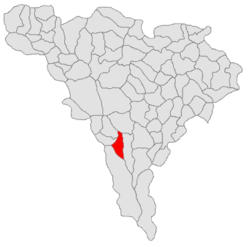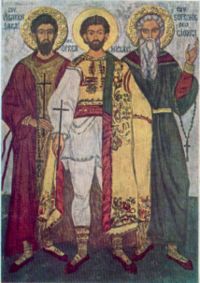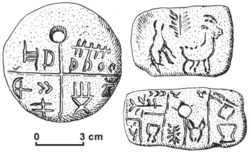- Săliştea
-
For other uses, see Săliştea (disambiguation).
Coordinates: 45°54′N 23°24′E / 45.9°N 23.4°E
Săliştea — Commune — Location in Alba County Location in Romania Coordinates: 45°54′N 23°24′E / 45.9°N 23.4°E Country  Romania
RomaniaCounty Alba County Population (2002)[1] - Total 2,374 Time zone EET (UTC+2) - Summer (DST) EEST (UTC+3) Săliştea (German: Tschorren), known as Cioara until 1965, is a commune located in Alba county, Romania. The old name of Cioara is still widely used, especially by local residents.
It is composed of four villages: Mărgineni, Săliştea, Săliştea-Deal and Tărtăria.
Contents
Geography
Săliştea is located near the Mureş River in the South-West of Alba county. The centre of the commune is situated 5 km north of a main Romanian National Road, namely the DN7, to which is connected by the county road 705E. The nearest cities are Sebeş (21 km), Cugir (25 km) and the county capital, Alba Iulia (27 km).
The bordering communes are Blandiana in the north, Vinţu de Jos in the north-east, Pianu in the east, the town of Cugir in the west and Şibot in the south.
The relief is dominated by the low terraces of the river Mureş in the north and the high plateau and several hills in the south. The highest hills, Globul, Hǎlmul and Coasta Rǎchitii, are about 700-900 metres high. Other hills are Vǎratecul (630 m), Dealul Mare (452 m), Dealul Ciorii (424 m), Dealul Calului (389 m) and Munceii Rotunzi (341 m).
The medium annual temperatures range between 5 and 9 degrees Celsius.
History
The oldest traces of human activity in Săliştea date back to the Vinča culture of the Middle Neolithic.
Other archaeological findings indicate the existence of a Dacian settlement in this area. The main discovery was a series of 62 pieces of silver artifacts, found in 1820 by Matei Molodeţ, a villager from Săliştea.[2] Several coins dated back to the times of Roman Dacia were also found by archaeologists.
The first attestation of a village in the area occupied today by Săliştea dates back to 4 November 1310, when by order of king Charles I of Hungary, the village of Archişul Românesc (Romanian Archiş) was donated to Count Reneriu from Vinţu de Jos. The other village, Drejman, was attested in a document from 29 June 1375, when by order of king Louis I of Hungary, villa Drasman is inherited by Reneriu's granddaughters.
On 23 May 1458 Archişul Românesc and Drejman were united to form the village of Cioara, named after the stream Cioara, a tributary of river Mureş. It is possible that the stream Cioara was named after the famous inn close to the village of Archişul Românesc and Drejman, that had as an emblem a crow (in Romanian: cioarǎ or corb). The emblem of the inn was also the emblem of the Barcsay noble family from Bârcea Mare, Hunedoara, that was attested in this area in several documents from 1458 and 1462, and became the dominant noble family in Săliştea starting from 1508.
The village of Cioara is linked to Sofronie of Cioara, the Eastern Orthodox Monk and Saint of the Romanian Orthodox Church who, between the autumn of 1759 and the spring of 1761, led the peaceful uprising of the Romanian Orthodox population against the Habsburg policy of encouraging all Romanians to join the Greek-Catholic Church. In 1701, the Emperor Leopold I decreed Transylvania's Orthodox Church to be one with the Roman Catholic Church. Sofronie's peaceful uprising advocated for freedom of worship and the right of the Romanian population in Transylvania to have a Romanian Orthodox bishop. As a response to Sofronie's movement, the Austrian military commander systematically destroyed the monasteries in Transylvania that had served as centres of the uprising, including the one in Cioara. In the end however, The Orthodox achieved a notable victory: recognition by the court of Vienna of the legal existence of their church and the appointment of a bishop in person of Dionisie Novacovic.[3]
Several historians also showed the involvement of several villagers from Cioara in the Revolt of Horea, Cloşca and Crişan[4] and the Transylvanian Memorandum movement.
A number of 550 inhabitants of Cioara fought during World War I in the Austro-Hungarian Army and most of them as volunteers in the Romanian Army in the second part of the war. Sixty-five of them were reported dead in action.
On 1 December 1918, the Alba Iulia National Assembly proclaimed the Union of Transylvania with Romania. Several people from Cioara took part in the assembly, including the local priest, Constantin Oancea, who was one of the speakers in the Assembly.
During World War II, more than 250 people from Cioara fought in the Romanian Army, of which 45 died in action. After the war, 65 children from Bessarabia, including their teacher, found refuge in the commune.
The name of the commune was changed in 1965 from Cioara to Săliştea.
Population
According to the 2002 Census, there are 2,374 people living in Săliştea (100% Romanians), of which 1,252 in the centre of the commune, 745 in Tărtăria, 309 in Săliştea Deal and 77 in Mărgineni.
Tărtăria tablets
The Tărtăria tablets were discovered in the village of Tărtăria, which is part of the Săliştea commune, in 1961 by a team of Romanian archaeologists led by Nicolae Vlassa.
Famous natives
- David Prodan (1902–1992), Romanian historian
- Sofronie of Cioara, Eastern Orthodox Monk and Saint of the Romanian Orthodox Church
See also
References
- ^ (Romanian) "Săliştea", at the Erdélyi Magyar Adatbank's Recensământ 2002; Retrieved on September 4, 2009
- ^ Studii şi cercetǎri de istorie veche şi arheologie, 1969, pp.319
- ^ Keith Hitchins, The Romanians 1774-1866, Oxford, 1996, pp.202-203
- ^ David Prodan, Rǎscoala lui Horea, Editura Ştiinţificǎ si Enciclopedicǎ, Bucureşti, 1979
External links
- (Romanian)(English)Săliştea website
- Traditional costume from Săliştea
Alba County, Romania Cities 
Towns Abrud · Baia de Arieş · Câmpeni · Cugir · Ocna Mureş · Teiuş · Zlatna
Communes Albac · Almaşu Mare · Arieşeni · Avram Iancu · Berghin · Bistra · Blandiana · Bucerdea Grânoasă · Bucium · Câlnic · Cenade · Cergău · Ceru-Băcăinţi · Cetatea de Baltă · Ciugud · Ciuruleasa · Crăciunelu de Jos · Cricău · Cut · Daia Română · Doştat · Fărău · Galda de Jos · Gârda de Sus · Gârbova · Hopârta · Horea · Ighiu · Întregalde · Jidvei · Livezile · Lopadea Nouă · Lunca Mureşului · Lupşa · Meteş · Mihalţ · Mirăslău · Mogoş · Noşlac · Ocoliş · Ohaba · Pianu · Poiana Vadului · Ponor · Poşaga · Rădeşti · Râmeţ · Rimetea · Roşia de Secaş · Roşia Montană · Sălciua · Săliştea · Sâncel · Săsciori · Sântimbru · Scărişoara · Stremţ · Şibot · Sohodol · Şpring · Şugag · Şona · Unirea · Vadu Moţilor · Valea Lungă · Vidra · Vinţu de Jos
Categories:- Archaeological sites in Romania
- Communes in Alba County
Wikimedia Foundation. 2010.




